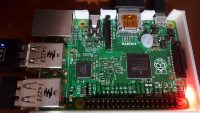You are using an out of date browser. It may not display this or other websites correctly.
You should upgrade or use an alternative browser.
You should upgrade or use an alternative browser.
Raspberry Pi 2
- Thread starter HalfEatenPie
- Start date
-
- Tags
- multicore raspberry pi
Mine will be here on Monday.It's here, it's here, it's here!
Too bad I'm leaving the house to enjoy the sunlight.
I'll play with it later!
Oh the joy!!!
Haha oh wait i uses microSDs now?Oh, derp... it requires a microSD card... the only one I have is being used for something else (Mobius actioncam)
Hrm. Guess I need to get a new microSD card...
Shit.
drmike
100% Tier-1 Gogent
Those numbers don't at quick glance look so hot.
UnixBench (w/ all processors)
500.3
UnixBench (w/ one processor)
197.3
So single processor = 197 but 4 cores = 500.... You'd expect, oh 700+.
Wondering if when folks get this running, if they will see cores being used and all properly without custom tweaking or idle cores often.
So guys. Plug you new Pi in and have it running. Take a photo of it with a camera flash. It's likely going to cause your Pi to power down...
Don't believe me? http://www.raspberrypi.org/forums/viewtopic.php?f=28&t=99042
Don't believe me? http://www.raspberrypi.org/forums/viewtopic.php?f=28&t=99042
drmike
100% Tier-1 Gogent
What the hell is that? a new feature to off computers for government control? Strangest thing I've seen in a long while. Guess a case to protect it is necessary on that modelSo guys. Plug you new Pi in and have it running. Take a photo of it with a camera flash. It's likely going to cause your Pi to power down...
Don't believe me? http://www.raspberrypi.org/forums/viewtopic.php?f=28&t=99042
It appears to only do it when taken with an xenon flash vs that of an LED flash. Strange indeed.

Someone covered that chip with blue-tac and confirmed it was the culprit as it stopped powering down afterwards:It appears that U16, the SMPS chip, is the culprit.

Yes, bit of bluetac on that chip and it survives the flash:
Looking at the board under strong light, both U8 and U16 are much more reflective than other chips,
but as you say covering U16 fixes the issue.
Why. Isn't the power being consumed by the Raspberry Pi not profitable at all?I love using my RPI, it's so lightweight - I use it with my S-crypt miner.
drmike
100% Tier-1 Gogent
What is the electronic component that they covered in that blue-tac hack?It appears to only do it when taken with an xenon flash vs that of an LED flash. Strange indeed.
Someone covered that chip with blue-tac and confirmed it was the culprit as it stopped powering down afterwards:
What is the electronic component that they covered in that blue-tac hack?
It appears that U16, the SMPS chip, is the culprit.
drmike
100% Tier-1 Gogent
That would appear to be a power related piece. Any discussion elsewhere about it? Unsure how someone accidentally missed this design shortcoming.What is the electronic component that they covered in that blue-tac hack?It appears that U16, the SMPS chip, is the culprit.
It's been mentioned in a few places today. It's now known, but interestingly enough this isn't the first time a component or piece of electrical equipment has experienced this...That would appear to be a power related piece. Any discussion elsewhere about it? Unsure how someone accidentally missed this design shortcoming.
http://www.nrc.gov/reading-rm/doc-collections/gen-comm/info-notices/1997/in97082.html
Information Notice No. 97-82: Inadvertent Control Room Halon Actuation due to a Camera Flash
At 9:45 a.m., the training representative took a flash photograph of the alarm reset/silence pushbuttons inside the FDS control panel. The first flash caused an annunciator inside the panel to sound. The cabinet door on the panel was closed and an examination of the front panel showed no lock-in alarm indications. The cabinet door on the panel was reopened and a second flash photograph was taken within 2 minutes of the first picture. The second flash caused a second alarm with a different tone, indicating that system actuation was imminent. Within 3 to 5 seconds of the second flash, Halon discharged from the overhead nozzles. The discharge occurred at 9:47 a.m. and lasted for 10 to 12 seconds. It was characterized by a loud roar, fog, and significant air turbulence.
http://www.antipope.org/charlie/blog-static/rants/nothing-like-this-will-be-buil.html
For starters, some embedded controllers in racks in the auxilliary deisel generator control rooms have EPROMs which have been known to be erased by camera flashes in the past, triggering a generator trip; for seconds, we had to wear protective clothing -- try explaining to a visitor that their expensive Nikon has been contaminated and needs to be left behind!
Last edited by a moderator:
drmike
100% Tier-1 Gogent
OMG, camera flash wiped EEPROM in nuclear facility and exposed people to radiation is what I got from that.
Simple frequency at play here. Might be impacted otherwise - non visible light areas. Really concerning in general since indicates fragility of component.
I am no electronics engineer, but I suspect quite a bit of equipment isn't properly hardened and susceptible to targeted frequency attacks - attacks that otherwise would go unnoticed and create no other signs of their presence.
Hi
Sorry, I might be old but does no one remember the Simpson episode where the robots were killed by simple cameras with flash bulbs. It was the itchy and scratch theme park episode.
That was in the nineties I think, and good to see it holds true today, in case were ever invaded by robots.
Many thanks
John
Sorry, I might be old but does no one remember the Simpson episode where the robots were killed by simple cameras with flash bulbs. It was the itchy and scratch theme park episode.
That was in the nineties I think, and good to see it holds true today, in case were ever invaded by robots.
Many thanks
John
Good to know, guess I shouldn't take a Polaroid snap of it when it comes in lol.
Still need to grab a case and stuff for it. Maybe I should have taken a trip over to Microcenter for all of this.
Still need to grab a case and stuff for it. Maybe I should have taken a trip over to Microcenter for all of this.

